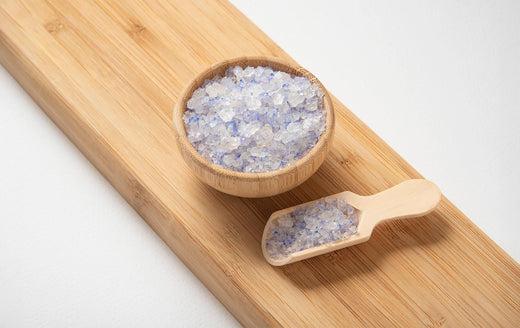Let's talk about the blue Salt. Forget for a moment. Its incredibly low sodium content and exceptional potassium levels make it a potassium-rich salt. Let's also set aside its unprocessed, natural qualities. Instead, this article will focus solely on its mesmerizing color and unravel the mystery behind its azure hue.
Where does Blue Salt come from?
Much like its pink counterpart, blue Salt originates from ancient dried seas. What sets it apart is its rarity. Blue Salt isn't just mined; it's discovered. It’s a precious gem unearthed from the depths of time. Picture those long-dried seas that existed millions of years ago when dinosaurs roamed the earth. The world has naturally shaped this rare crystal for millions of years, and it is now ready to enhance our culinary creations.

How the color appears: From the mines to your table
At first glance, the solid blue salt rock boasts a deep blue hue. In the mines, it shows up as veins of blue, similar to gold. The solid blue pieces refract the light to produce a deeper blue color in the solid rocks. But when fractured into smaller pieces for grinding, its coarse texture reveals smaller pieces of deep blue surrounded by Salt that is softer and lighter.
Is the blue color natural?
Yes! Certified Laboratories' test on our blue Salt confirmed that the vibrant blue coloration is intrinsic to the product. The color dissolved seamlessly in distilled water, affirming its natural origin and purity, devoid of human intervention.

Where does the blue come from?
Blue Salt is incredibly mineral rich, containing over 60 different minerals. Eupherbia Blue Salt has lower levels of sodium than Pink Salt, Sea Salt, and especially Table salt and has 6% of your daily value of Potassium in every tablespoon. The blue color comes from this mineral richness, specifically in Sylvinite, a natural mix of potassium chloride and sodium chloride with unique crystal patterns.
Light Interaction
Pressure over millions of years creates tiny imperfections in the crystals, which make them reflect light with a blue hue. When the Salt is broken into smaller pieces, the reduced crystal size lowers light refraction, making the color lighter.
Natural Formation
The color is natural, formed deep within ancient salt deposits under unique geological conditions.
Final Thoughts
Blue Salt has unparalleled characteristics with lower sodium than other salts, higher potassium, and mineral-rich with over 60 minerals, not to mention its calm blue color! Head to eupherbia.com to try Eupherbia Blue Salt in a 100 gr grinder or for the best value 227 gr pouch.



Share:
Get the Most Out of Your Saffron: A Simple Guide to Brewing Saffron
How to Distinguish Real Saffron from Fake